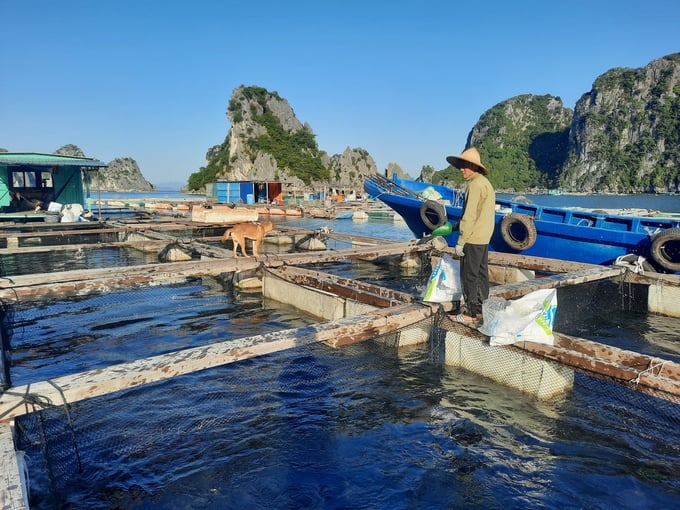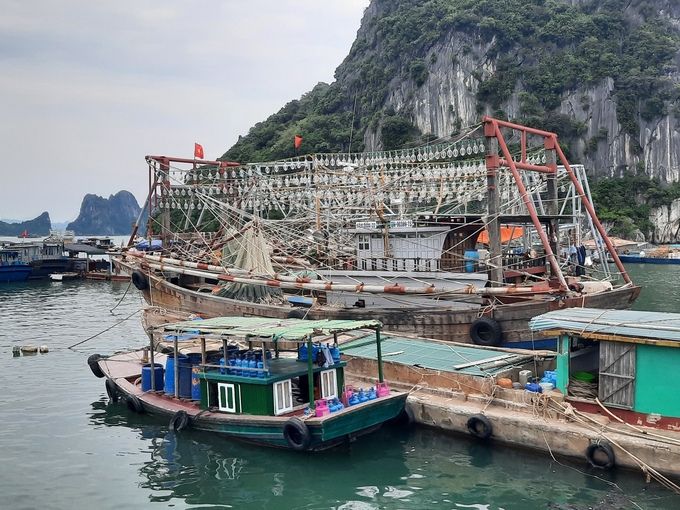May 21, 2025 | 03:03 GMT +7
May 21, 2025 | 03:03 GMT +7
Hotline: 0913.378.918
May 21, 2025 | 03:03 GMT +7
Hotline: 0913.378.918
Quang Ninh currently has over 6,100 square kilometers of water surface and sea area, with thousands of islands of varying sizes, many clumps and ponds, a diverse and rich ecosystem, as well as many aquatic species of high economic value. This is an important advantage for Quang Ninh province to develop a sustainable seafood industry, with the ultimate goal of becoming a seafood export center in the North.

Quang Ninh aims to increase farming and reduce natural exploitation. Photo: Nguyen Thanh.
The seafood output in Quang Ninh reached nearly 150,000 tons in 2021; the production value reached more than 13,000 billion VND, accounting for 52.5% of the value of the entire agricultural sector; the total aquaculture area reached 21,300 hectares; containing 5.42 billion breeders of all kinds.
Quang Ninh is aiming to increase aquaculture, reduce fishing and exploitation. In addition, the province has also enhanced the guidance of local governments and units to adopt a reasonable farming structure, develop shrimp and fish farming areas with high technology and environmentally friendly applications; strongly develop the key aquaculture products including shrimp and molluscs.
Namely, policies to attract focused, key, and oriented investments in the seafood industry have been effective. As a result, different large businesses have had the opportunity to develop in the province.
Most notably, Vietnam - Australia Group, after 2 years of construction starting from 2019, has produced the first batch of shrimp seed. Consequently, the shortage of breeding shrimp has been solved. In the last year, 24 hatcheries belonging to Vietnam - Australia Group produced nearly 1 billion seed, 70% of which were supplied to shrimp farming facilities in the province. Thereby, creating a stepping stone to raise the level of shrimp in the structure of Quang Ninh aquaculture.
With a rapid growth, the seafood industry in Quang Ninh province is facing multiple great opportunities to continue developing breakthroughs. It is forecast that by 2025, the total value of seafood production will increase by at least 1.5 times compared to that of 2020, accounting for 55 to 60% of the total production value of the province's agricultural sector. On the other hand, Quang Ninh also improves its seafood processing capacity for export and domestic consumption, promoting its potential to become an important economic sector in the future.
Quang Ninh's development orientation aims to build the province into a center for aquaculture, processing and export of aquatic products in the Northern region until 2030, with a vision towards 2045. The province also focuses on rapidly developing key farming species, high-tech farming and new technology.
In the immediate future, Quang Ninh's seafood industry sets an output target of 153,000 tons; 21,000 hectares of aquaculture area; strive to produce and supply aquatic breeds with 45 to 50% of varieties originating in the province.

The management of the fishing vessels is a priority task for the Quang Ninh seafood industry. Photo: Nguyen Thanh.
The EU-Vietnam Free Trade Agreement (EVFTA) is opening up great opportunities for Vietnam's seafood exports. However, it can be quite difficult to overcome the extremely strict capital requirements of the EU market.
With the advantage of a long coastline, large farming and fishing areas, Quang Ninh province is home to several seafood processing businesses, including those capable of processing to meet export standards to traditional markets such as China, Japan, Taiwan and other similar markets. These businesses process and export thousands of tons of products ranging from bivalve molluscs to fish and shrimp of all kinds every year.
When the EVFTA Agreement came into effect on August 1, 2020, these businesses also want to take advantage of the available technical infrastructure as well as invest in new equipment to process and produce in compliance with European market requirements.
Quang Ninh seafood import and export businesses are willing to invest in new equipment to process and produce in accordance with the requirements of the European market. Businesses can be proactive in managing modern technology or production line, but for Vietnamese seafood products or Quang Ninh's products in particular to reach European customers, they must have a legal origin as well as be transparent regarding food safety and hygiene criteria.
The applicable standard must be raised from VietGAP to GlobalGAP; the processing capacity must also be increased, so that products can be preserved for an extended period of time. This will make them suitable for the EU market, which has a larger geographical distance compared to the traditional markets such as China and Japan.
Mr. Tran Dinh Luan, Director General of the Directorate of Fisheries under the Ministry of Agriculture and Rural Development said that, in addition to safe farming areas, Quang Ninh needs to handle and deal with recommendations on combating IUU fishing and aquaculture.
“Quang Ninh province must be able to manage fishing vessels, especially those of 15 meters or more in length; equip them with cruise control system, color paint and so on. Post-harvested products need to declare output and types at the docking ports, submit the fishing log as a basis to evaluate processed products for export", Mr. Luan emphasized.
When the EVFTA came into effect, many Vietnamese seafood product lines exported to the EU will be enjoy a 0% tariff, but more diversified and stricter non-tariff measures will also be applied widely. Therefore, Vietnam's seafood industry as well as Quang Ninh seafood businesses require support in terms of capital, application of science and technology, market development and trade promotion among others.
Seafood businesses in Quang Ninh are making efforts to improve product quality, improve competitiveness in a sustainable manner and comply with the provisions of the law, to gradually expand the market and bring Quang Ninh closer to the international market.
Translated by Nguyen Hai Long

(VAN) Japan's grant aid project contributes to capacity building, promoting organic agricultural production, and fostering sustainable community development in Dong Thap province.

(VAN) For years, the CRISPR-Cas9 genome technology has been reshaping genetic engineering, a precision tool to transform everything from agriculture to medicine.

(VAN) Vietnam aims to become a 'leader' in the region in the capacity and managing effectively soil health and crop nutrition.
![Reducing emissions from rice fields: [Part 1] Farming clean rice together](https://t.ex-cdn.com/nongnghiepmoitruong.vn/608w/files/news/2025/05/05/z6509661417740_a647202949c539012a959e841c03e1d3-nongnghiep-143611.jpg)
(VAN) Growing clean rice helps reduce environmental pollution while increasing income, allowing farmers to feel secure in production and remain committed to their fields for the long term.
/2025/05/19/5136-1-144800_230.jpg)
(VAN) The Nghe An Provincial People's Committee has just approved the list of beneficiaries eligible for revenue from the Emission Reductions Payment Agreement (ERPA) in the North Central region for the year 2025.

(VAN) 14 out of 35 domesticated elephants in Dak Lak province have had their living conditions improved, with 11 of them currently participating in the non-riding elephant tourism model.

(VAN) Muong Nhe Nature Reserve hopes that being upgraded to a national park will lay the foundation for forest protection efforts to be carried out in a systematic, modern, and sustainable manner.